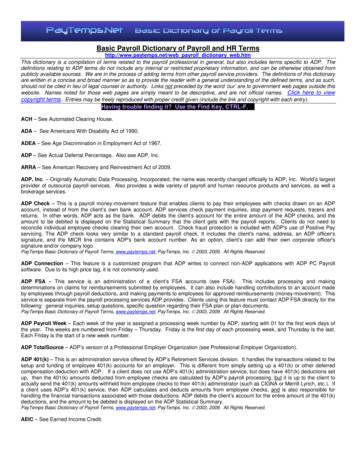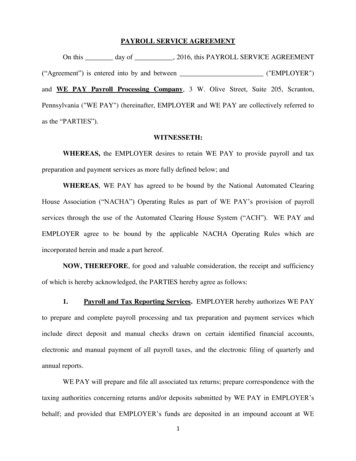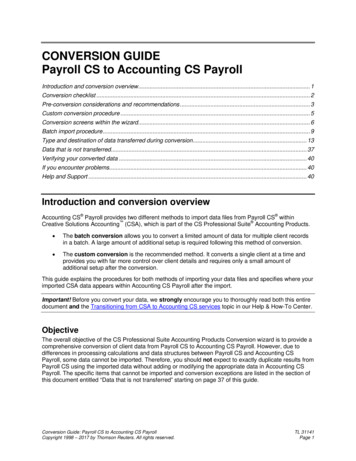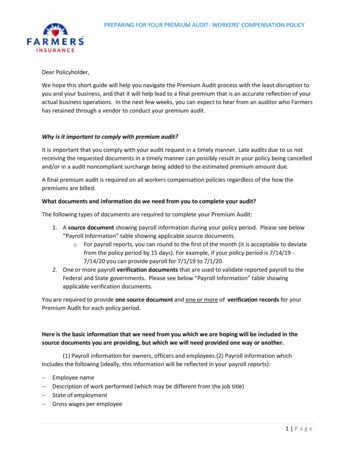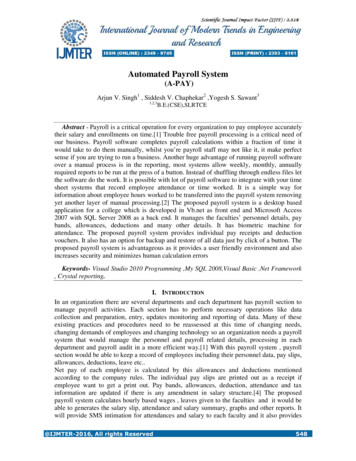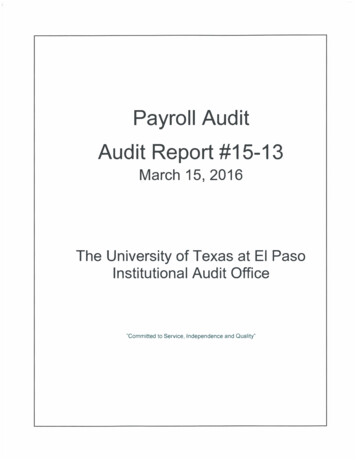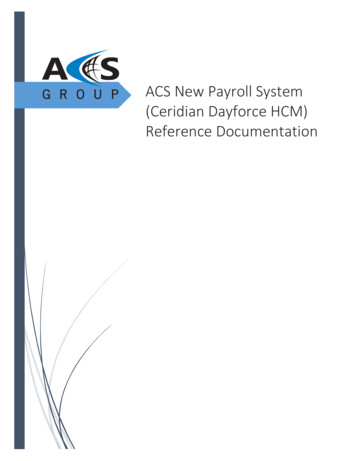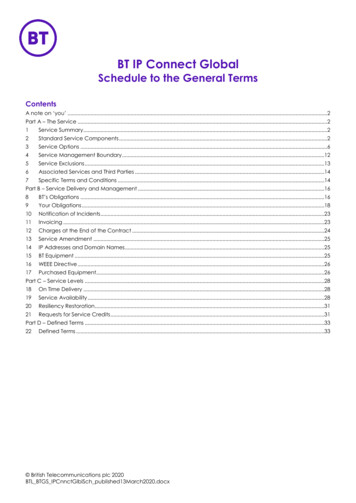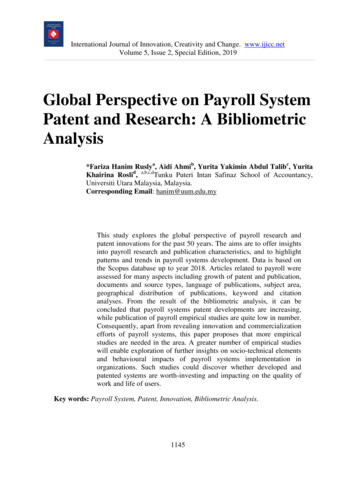
Transcription
International Journal of Innovation, Creativity and Change. www.ijicc.netVolume 5, Issue 2, Special Edition, 2019Global Perspective on Payroll SystemPatent and Research: A BibliometricAnalysis*Fariza Hanim Ruslya, Aidi Ahmib, Yurita Yakimin Abdul Talibc, YuritaKhairina Roslid, a,b,c,dTunku Puteri Intan Safinaz School of Accountancy,Universiti Utara Malaysia, Malaysia.Corresponding Email: hanim@uum.edu.myThis study explores the global perspective of payroll research andpatent innovations for the past 50 years. The aims are to offer insightsinto payroll research and publication characteristics, and to highlightpatterns and trends in payroll systems development. Data is based onthe Scopus database up to year 2018. Articles related to payroll wereassessed for many aspects including growth of patent and publication,documents and source types, language of publications, subject area,geographical distribution of publications, keyword and citationanalyses. From the result of the bibliometric analysis, it can beconcluded that payroll systems patent developments are increasing,while publication of payroll empirical studies are quite low in number.Consequently, apart from revealing innovation and commercializationefforts of payroll systems, this paper proposes that more empiricalstudies are needed in the area. A greater number of empirical studieswill enable exploration of further insights on socio-technical elementsand behavioural impacts of payroll systems implementation inorganizations. Such studies could discover whether developed andpatented systems are worth-investing and impacting on the quality ofwork and life of users.Key words: Payroll System, Patent, Innovation, Bibliometric Analysis.1145
International Journal of Innovation, Creativity and Change. www.ijicc.netVolume 5, Issue 2, Special Edition, 2019IntroductionAs the world faces rapid change in technology nowadays, there is no doubt that the payrollprocessing system, a core component of human resource management, is also experiencing atransformation into a digital platform. When payroll process is automated, the tedious andclunky manual calculations of employees pay require less work, effort and time, especiallyfor big organizations. The idea of taking control of the process through innovation of acomputerized payroll system is advantageous as it minimizes human calculation errors,increases data security from breaches, and enhances competitiveness [1, 2].Since there are increased innovations in payroll system [3], it is imperative to identifywhether the innovations are patented. The purpose of patent is to acknowledge originalinventor w with an intellectual property right so that the innovation is protected [4]. Inaddition, a patent of innovation is a measurement of output from innovation activity and anindicator of company technological strengths [5, 6]. To achieve a better understanding of theextent to which companies patent their computerized payroll system, this research sough toknow the number of innovations that are patented in the absence of such data exists.Therefore, the objectives of this study are twofold. First, this study aims to identify payrollsystems innovation patent trends from previous research conducted and the patentorganizations involved. Secondly, due to the importance and advantages offered by thecomputerized payroll system, this study examines the temporal trends of researchpublications in the field of computerized payroll system to identify high priority issues.Literature ReviewPayroll processing is vital for an organization and it is regularly incorporated in humanresource management systems. It is a special-case purchasing system as organizations‘purchase’ and pay for their employees instead of raw materials or goods [7]. Payrollprocessing system helps organizations efficiently, accurately, systematically and in a timelymanner, process employees’ salary, allowance, overtime and deductions [8]. In addition, itassists employers to comply with government regulations and tax authorities as well as meetmoral and statutory obligation to employees by contributing to the employee provident fundand social security [9].1146
International Journal of Innovation, Creativity and Change. www.ijicc.netVolume 5, Issue 2, Special Edition, 2019In processing payroll, organizations must adhere to latest rules or acts by the relevantgovernment authorities such as re-allocation of employee’s contribution in EPF and taxlegislation that may periodically change. Therefore, it is important for an organization toadopt payroll system that is reliable, reduces errors and helps organization to easily adjust tochange [1]. Indirectly, these would then increase the motivation and productivity of theemployees [10, 11].A computerized payroll system is a software package to record, organize, and maintainemployee data, such as names, addresses and pay rates, electronically. During each payperiod, it calculates payroll deductions (e.g., EPF, SOCSO), allowances (e.g., meal,transportation) and taxes, produces pay slips and keeps all data up-to-date. Small-scalepayroll software can be obtained off-the-shelf, such as SQL, Autocount and MYOB, to namea few. Mid-range software typically handles management and accounting tasks, such asproducing tax documents (EC Form) and financial statements. High-end payroll software iscommonly part of the enterprise resource planning (ERP) software that integrates businessfunctions and can be tailored towards businesses’ needs. Regardless of business size and thetype of payroll software, all businesses should employ a computerized payroll system to drivesuccess.Prior studies report that payroll system literature is expanding in the past five years and hasbeen largely published as journal articles and academic dissertations [3]. This study foundthat most existing literature focused on the development and implementation of payrollsystem in organizations. However, this study is limited to certain characteristics in itsbibliometric analysis. It is argued that more studies can be included in the analysis toestablish further direction in the payroll literature. Therefore, this study is conducted to fillthe gap with a wider selection of characteristics in the payroll system bibliometric analysisand extends its coverage to include innovation patent trends of payroll systems.MethodsThis study employs a bibliometric analysis that aims to discover a recent trend in payrollsystem studies and innovations. Bibliometric analysis refers to a quantitative method thatuses statistics to measure text and information and enables analysis of physical publicationsof articles or bibliographic units [12,13]. The analysis could provide descriptive patterns ofpublications completed based on a domain, field, country, period, or amongst all of thepreceding [14]. Additionally, a systematic approach required in performing a bibliometricanalysis could discover more detailed information related to the publications, including1147
International Journal of Innovation, Creativity and Change. www.ijicc.netVolume 5, Issue 2, Special Edition, 2019authors, frequency of keywords and citations. Most importantly, bibliometric analysis allowsresearchers to explore patterns of past studies from historical data and consequently indicatestopic visibility and future development in the area [13].The bibliometric analysis in the current study was conducted based on the online version ofpublications in the Scopus database. Scopus is the largest database of peer reviewed literaturethat includes scientific journals, books and conference proceedings [15]. The databaseconsists of approximately 36 000 titles from almost 11 000 publishers with citation referencesmainly in peer-reviewed journals across subject fields of social, physical, health and lifesciences. The online database was searched using the following query with keywords of(TITLE-ABS-KEY ("payroll system" OR "payroll software" OR "payroll application")). Thedata was retrieved on 7th March 2019 and consists of data up to the year 2018. This queryproduced a total of 2,367 patents and 110 documents. After conducting a review of thedocuments, it was found that 10 documents were not within the scope of payroll systemrelated study and there was one duplicate item [Atici, 2018]. Thus, 2,367 patents and 99documents were be used to conduct this bibliometric analysis.Analysis and FindingsAll the articles referring to payroll that met the query search characteristics were assessedfrom the following aspects: growth of patent and publication, documents and source types,and language of publications, subject area, geographical distribution of publications, keywordand citation analyses, and number of authors for publication.A. Annual Growth of Patent and PublicationTable 1 below summarizes details about the total patents registered related to payrollsystem since 1916. As per Scopus records, the first patent registered on payroll system wasbased on the work by Amos H. Hawley (International Money Machine Company) on PlatenFeed Mechanism [16]. Growth on the patent is quite slow due to the slow trend ofinformation technology until the year of 2001 where the percentage of its growth increasedmore than 1%. Since then, there increasing numbers of innovation-related payroll systemshave been registered. The highest number of registered patents was observed in 2013, wherea total of 202 representing 8.53% of patents were registered.Table 1: Total Patents Registered by YearYearFrequency19161% (N 2367)0.041148Cumulative Percent0.04
International Journal of Innovation, Creativity and Change. www.ijicc.netVolume 5, Issue 2, Special Edition, .992.032.202.282.412.492.793.083.463.974.65
International Journal of Innovation, Creativity and Change. www.ijicc.netVolume 5, Issue 2, Special Edition, 86.9995.23100.00At the same time, the organizations where those patents were registered was analyzed. It wasrevealed that more than 93% of the patents were registered in the United States Patent andTrademark Office. Table 2 below summaries these details.Table 2: Patent OfficePatent OfficeUnited States Patent & TrademarkOfficeWorld Intellectual PropertyOrganizationEuropean Patent OfficeJapan Patent OfficeUnited Kingdom Intellectual PropertyOfficeTotalFrequency2206% (N 1150
International Journal of Innovation, Creativity and Change. www.ijicc.netVolume 5, Issue 2, Special Edition, 2019While there is substantial growth in the innovation of patents registered for payroll systemsand applications, the number of article publications was not as significant as patents. Thereare only 99 documents published on the payroll system, from 1969 to 2018 that have beenindexed in the Scopus database. As per Scopus records, the first published research on payrollsystem was by Reizer and Harbison [17] titled By-Products of a Hospital Payroll System. Thetotal number of articles written every year was less than 10 and the highest number ofpublications, 7 in total, was recorded in 2017, representing 7.07% of the total documents.Table 3 below shows the growth of publications related to payroll systems.Table 3: Growth of Publication by YearYearFrequency% (N 0.6162.63
International Journal of Innovation, Creativity and Change. www.ijicc.netVolume 5, Issue 2, Special Edition, 385.8687.8894.95100.00B. Document and Source TypeDocument type refers to a type of document based on the originality of the document aseither an article, conference paper orbook chapter etc., while source type is the type of asource document whether it is a journal, conference proceedings, book series, a book or tradepublication. According to Sweileh et al. [18], a conference paper that appeared underdocument type could differ from one that appeared under the source type, for example, apaper presented in a conference will be classified as a conference paper under document type[Ashraf, Shafiq & Batool 2017]. However, the same paper maybe classified as a full journalarticle, conference proceeding or book chapter under source type, depending on itspublication status. As summarized in Table 4 below, the documents published on payrollsystem are spread into seven document types. As indicated further, more than half of the totalpublications are in the form of an article (50.51%), followed by conference papers (37.37%).Other type of documents represented less than 5% of the total publication respectively.Table 4: Document TypeDocument TypeArticleConference PaperReviewBook ChapterShort SurveyConference ReviewEditorialTotalFrequency503743311991152% (N 99)50.513
computerized payroll system is advantageous as it minimizes human calculation errors, increases data security from breaches, and enhances competitiveness [1, 2]. Since there are increased innovations in payroll system [3], it is imperative to identify whether the innovations are patented. The purpose of patent is to acknowledge original inventor w with an intellectual property right so that .
